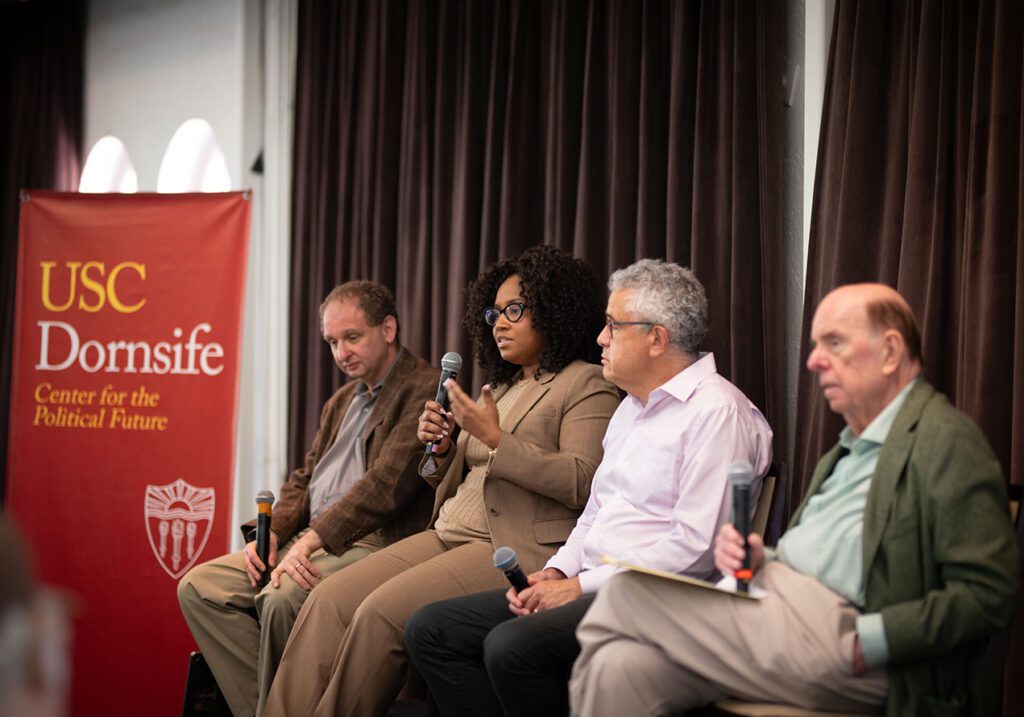Three students join innovation competition to create new business model
—By Lori Craig
Forget the billable hour. Drop the fancy lunches. Pay first-year associates less, but help them out with their student loans.
This is the firm of the future, at least as envisioned by USC Law students and others who recently participated in an innovative competition.
Second-year students Brigette Brennan and Kate Jones and 3L Lutfi Karuf, along with Prof. Gillian Hadfield, joined law firm partners and associates, in-house attorneys, and law firm clients from across the country in the FutureFirm competition, a role-playing game to craft a new law firm business model, held at Indiana University Maurer School of Law in April. Brennan was a member of the winning team.
The competition comes at a crucial time for law firms, according to Hadfield and her students.
“The conventional law firm model is widely seen to be in crisis, and the financial crisis of the past several months has only deepened that perception,” Hadfield said. “We are seeing law firms collapse, layoffs, deferrals and even cancellations of job offers and drastic cuts in summer jobs. But even before the financial collapse, pressures to revise the law firm model have been building.”
Among the problems: big-firm clients who are resistant to the conventional practice of firms hiring large numbers of new law school graduates and billing them out—despite real weaknesses in their training and skills—at $250 to $300 an hour; associate dissatisfaction and retention; and an unsustainable billing model.
Karuf, who spent the past two summers at two different firms, offered his perspective:
“There’s so much competition among the top firms for a small amount of people that it’s unrealistic in terms of the expectations that are placed on the associates coming into the firm,” he said. “[Young associates] are treated in such a way that you’re very privileged…I think that it creates a sense of entitlement and encourages people to do the work to get the work done but not to become a good lawyer, and not to actively seek out training opportunities.”
The competition, organized by Maurer Professor William Henderson and Anthony Kearns, lead risk manager for the Australian Legal Practitioners Liability Committee, was designed to address those problems and create a new law firm model likely to thrive 20 years into the future.
The 44 players were divided into four teams, with three students from different law schools on each team. Other team members included partners from Sullivan & Worcester, Forest Brown Todd, and the innovative Valorem Law Group and Summit Law Group; law firm clients who head the legal departments at Cisco, Discovery Communications and Tribune Corp.; and associates from Orrick and Jones Day. Hadfield served as a judge alongside leading attorneys, other law professors, the CEO of Legal OnRamp and the former general counsel of Stanford University.
Teams spent about eight hours strategizing. For Jones, the most challenging part of the competition was balancing the clients' concerns with the law firm's structure.
“Our clients liked the idea of young associates working in their law departments for a period of time to gain familiarity, but did not want to pay for the associates to be there,” Jones said. “The law firm, however, believed the associates were valuable assets to the client and the client should bear some of the cost of training. In the end, our team of clients and lawyers agreed to split the cost of the associate's salary during the period of time that the associate would be working in-house for the client.”
All three USC Law students said they were pleasantly surprised by how much they were able to contribute to the discussions.
“The other participants listened to and valued my point of view,” Jones said. “They were cognizant of the pressures associates face and wanted to make sure that they understood the associates’ concerns and values—what the younger generation is looking for in a firm.”
In the end, each of the four groups came up with unexpectedly similar future firms: no billable hours for associates; lower pay for associates but help paying back student loans or help with third-year tuition; more focused recruiting efforts; more training for associates; lower pay for partners; more partners working from home; alternative billing structures for clients; closer relationships between clients and firms; and secondments: temporary assignments for associates or partners serving a client in house.
“I was pleasantly surprised that all the teams came up with secondments because that’s definitely the kind of thing I would enjoy doing,” Karuf said. “This is the first time I’d heard of [secondments] actually being practical, and a major component of training.”
Brennan, who was a member of the winning team, said her group’s vision set their ideas apart.
“Our group completely abandoned the billable hour in our model and moved to an alternative value billing system,” she said. “Additionally, our group was the only one to focus on business development at the associate level. It was unique to our team to have the partners dedicate both their time and a budget to every associate so they can learn business development skills from their first day at the firm.”
Hadfield said: “Although the competition led to some interesting new ideas, it was also striking how little the final solutions departed from the set of solutions that are currently bandied about in the profession.
“I think the challenge facing true innovation in the way legal services are produced and priced is great, and this competition reinforced that conclusion. In my own view, we need more diversity of thinking—thinking by people who are not lawyers—to make significant changes.”

















